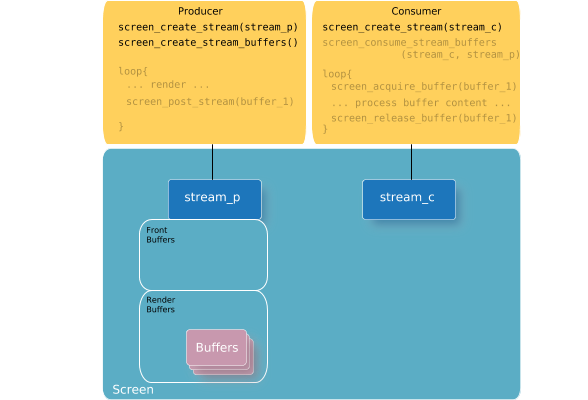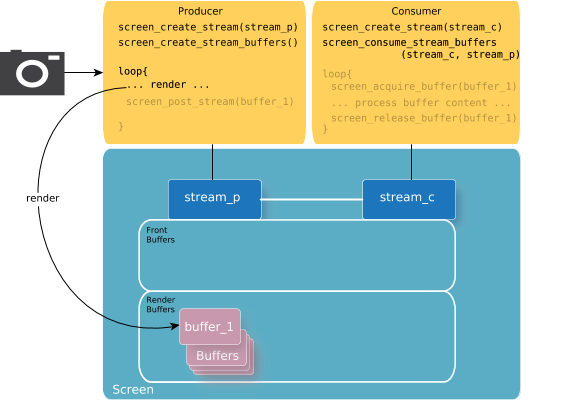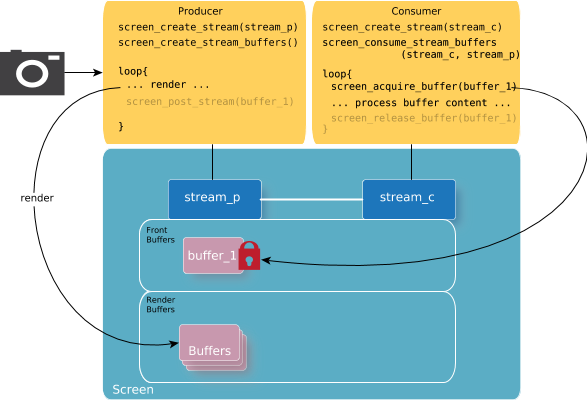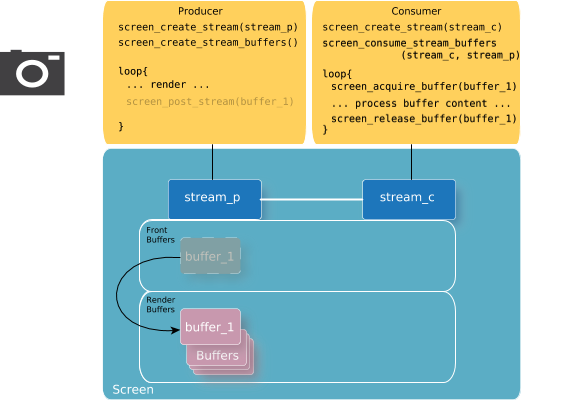Streams are off-screen, multi-buffered render targets that are provided by the Screen API.
Streams are used by consumers that are applications rather than Screen itself. In the case of windows, it's most common that the consumer is Screen because the content is intended to be shown on a display. However, the content of streams is intended to be consumed by other applications. These applications could be separate, in the same or different process, from the one that's producing the streams' content. A common case for using streams would be displaying output from a camera (or video) that requires some form of image processing on the camera's output before it's displayed.
Buffers of producer streams are created by calling screen_create_stream_buffers(). These buffers are used for either rendering or posting. Initially, all the buffers that are created, are available for rendering. As the buffers are posted, they become front buffers. The front buffers are once again available as render buffers when all consumers have released them. Render buffers are available for producer streams to safely render into. These buffers are retrieved using the SCREEN_PROPERTY_RENDER_BUFFERS property of the stream. Front buffers have been posted by the stream (i.e., screen_post_stream() was called with these buffers). These buffers are retrieved using the SCREEN_PROPERTY_FRONT_BUFFERS property of the stream. Consumers use the front buffers of producer streams when they are consuming content. We don't recommend rendering into any buffer that's not available in SCREEN_PROPERTY_RENDER_BUFFERS because there's a risk that a buffer that's not in this list, is actively being consumed.
Using streams generally implies a basic set of procedures for both the producer and the consumer. Content can be accessed by multiple applications or processes, so it's important that each of the producers and consumers understand how to provide and access the content. The Screen API provides the capability to perform what each of the producer and consumer are responsible for.
A simple description of a set of producer-consumer functions and interactions is illustrated below to provide a basic understanding of how streams are used to share content. The following steps don't include details and specifics; those are provided in later sections.
-
Initially, both producer and consumer create their own streams. The producer creates a stream (Stream-p
) with a set of buffers that it will render into. The consumer creates a stream (Stream-c), but doesn't
create any buffers because it intends to share those of the producer.

-
The producer starts rendering into one of its available render buffers. The consumer must call
screen_consume_stream_buffers()
to associate its stream to the producer's stream. Once the consumer establishes an association with
the producer, it can start waiting for content to be posted.

-
Once the producer is ready to make its content available, it posts the buffer to the stream. The buffer that was
used for rendering becomes the front buffer. Once the buffer is posted to the stream, it's available to consumers.

-
Once a front buffer is available, the consumer must acquire the buffer before it can start processing
the buffer's content. By acquiring the buffer, the consumer prevents this buffer from being made available
in the producer's list of render buffers (SCREEN_PROPERTY_RENDER_BUFFERS).

-
When the consumer is finished accessing the buffer from the producer, it needs to release
the buffer. By releasing the buffer, it allows the buffer to be updated by the producer.

-
When the consumer releases the front buffer, the buffer is made available again in the
producer's list of render buffers (SCREEN_PROPERTY_RENDER_BUFFERS).

Other important points on streams to note are:
-
Streams can't be reconfigured. That is, the following propeties can't be changed once a stream has been realized:
- SCREEN_PROPERTY_BUFFER_SIZE
- SCREEN_PROPERTY_FORMAT
- SCREEN_PROPERTY_USAGE
Once a stream has been created and realized, no new buffers can be created on that stream. If you need to change any of the properties listed above, you need to create a new stream and notify the consumers to share this stream instead.
Therefore, if you need to reconfigure your stream, you can do either of the following:
- Use your existing stream
-
You must destroy the buffers of your existing stream, reconfigure the stream by setting stream properties, and then recreate new stream buffers:
- Call screen_destroy_stream_buffers() on your existing stream.
- Reconfigure the stream by setting its properties through the screen_set_stream_property_*() Screen API functions.
- Call screen_create_stream_buffers() to recreate the stream's buffers that are based on your newly modified properties.
- Create an entirely new stream
-
You must destroy the existing stream, then create a new stream with the appropriate properties set.
- Call screen_destroy_stream() to free any resources allocated for your existing stream.
- Call screen_create_stream() to create a new stream.
- Configure the stream by setting its properties through the screen_set_stream_property_*() Screen API functions.
- Call screen_create_stream_buffers() to create buffers for the new stream.
-
If the producer locks up, it's usually because of how the consumer is acquiring and releasing buffers. When the consumer acquires buffers, it's essentially keeping those buffers as front buffers, and preventing them from returning to the producer's list of render buffers. The function screen_post_stream() waits until there's a render buffer available to the producer (i.e., at least one buffer indicated by SCREEN_PROPERTY_RENDER_BUFFERS). If the consumer doesn't release the buffers by the time that the producer posts again, then the producer is blocked waiting on the consumer to release buffers back into the producer's list of render buffers.
Screen releases any buffers that have been acquired by a consumer if the consumer terminates unexpectedly. Therefore, the producer won't be blocked indefinitely if one of its consumers crashes.
-
Streams require that the producer and the consumer be somewhat in synchronization with each other. Generally, there are fewer complications when you have a single producer stream associated with a single consumer stream.